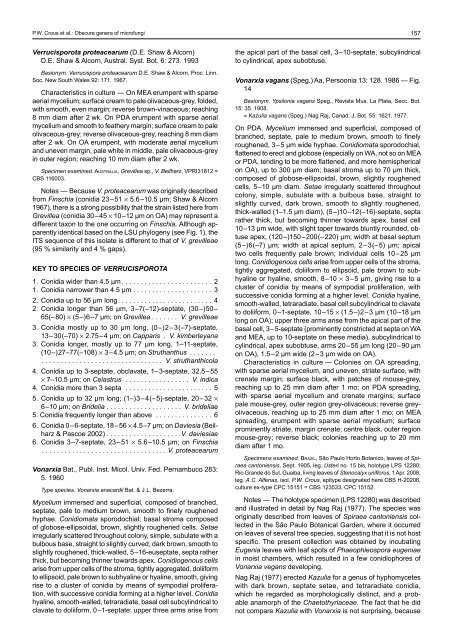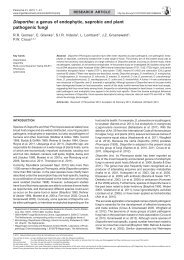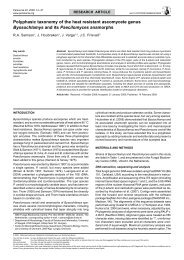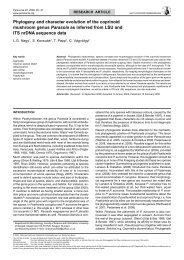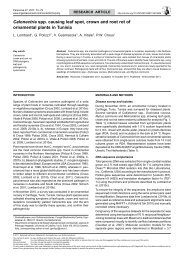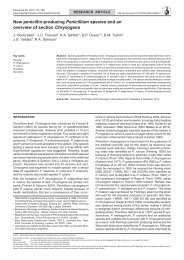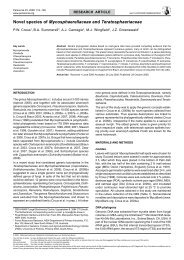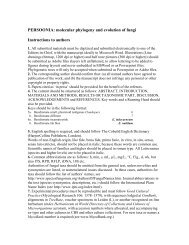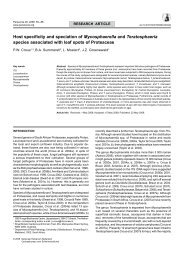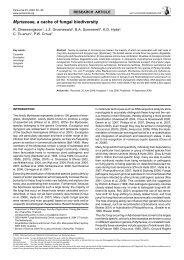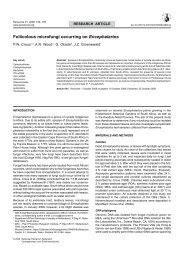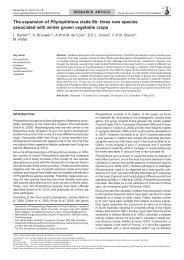Phylogeny and taxonomy of obscure genera of microfungi - Persoonia
Phylogeny and taxonomy of obscure genera of microfungi - Persoonia
Phylogeny and taxonomy of obscure genera of microfungi - Persoonia
Create successful ePaper yourself
Turn your PDF publications into a flip-book with our unique Google optimized e-Paper software.
P.W. Crous et al.: Obscure <strong>genera</strong> <strong>of</strong> micr<strong>of</strong>ungi<br />
157<br />
Verrucisporota proteacearum (D.E. Shaw & Alcorn)<br />
D.E. Shaw & Alcorn, Austral. Syst. Bot. 6: 273. 1993<br />
Basionym. Verrucispora proteacearum D.E. Shaw & Alcorn, Proc. Linn.<br />
Soc. New South Wales 92: 171. 1967.<br />
Characteristics in culture — On MEA erumpent with sparse<br />
aerial mycelium; surface cream to pale olivaceous-grey, folded,<br />
with smooth, even margin; reverse brown-vinaceous; reaching<br />
8 mm diam after 2 wk. On PDA erumpent with sparse aerial<br />
mycelium <strong>and</strong> smooth to feathery margin; surface cream to pale<br />
olivaceous-grey; reverse olivaceous-grey, reaching 8 mm diam<br />
after 2 wk. On OA erumpent, with moderate aerial mycelium<br />
<strong>and</strong> uneven margin, pale white in middle, pale olivaceous-grey<br />
in outer region; reaching 10 mm diam after 2 wk.<br />
Specimen examined. Australia, Grevillea sp., V. Beilharz, VPRI31812 =<br />
CBS 116003.<br />
Notes — Because V. proteacearum was originally described<br />
from Finschia (conidia 23–51 × 5.6–10.5 µm; Shaw & Alcorn<br />
1967), there is a strong possibility that the strain listed here from<br />
Grevillea (conidia 30–45 × 10–12 µm on OA) may represent a<br />
different taxon to the one occurring on Finschia. Although apparently<br />
identical based on the LSU phylogeny (see Fig. 1), the<br />
ITS sequence <strong>of</strong> this isolate is different to that <strong>of</strong> V. grevilleae<br />
(95 % similarity <strong>and</strong> 4 % gaps).<br />
Key to species <strong>of</strong> Verrucisporota<br />
1. Conidia wider than 4.5 µm . . . . . . . . . . . . . . . . . . . . . . . . 2<br />
1. Conidia narrower than 4.5 µm . . . . . . . . . . . . . . . . . . . . . 3<br />
2. Conidia up to 56 µm long. . . . . . . . . . . . . . . . . . . . . . . . . 4<br />
2. Conidia longer than 56 µm, 3–7(–12)-septate, (30–)50–<br />
65(–80) × (5–)6–7 µm; on Grevillea . . . . . . . V. grevilleae<br />
3. Conidia mostly up to 30 µm long, (0–)2–3(–7)-septate,<br />
13–30(–70) × 2.75–4 µm; on Capparis . V. kimberleyana<br />
3. Conidia longer, mostly up to 77 µm long, 1–11-septate,<br />
(10–)27–77(–108) × 3–4.5 μm; on Struthanthus . . . . . . .<br />
. . . . . . . . . . . . . . . . . . . . . . . . . . . . . . . . V. struthanthicola<br />
4. Conidia up to 3-septate, obclavate, 1–3-septate, 32.5–55<br />
× 7–10.5 µm; on Celastrus . . . . . . . . . . . . . . . . . V. indica<br />
4. Conidia more than 3 septa . . . . . . . . . . . . . . . . . . . . . . . 5<br />
5. Conidia up to 32 µm long; (1–)3–4(–5)-septate, 20–32 ×<br />
6–10 µm; on Bridelia . . . . . . . . . . . . . . . . . . . . V. brideliae<br />
5. Conidia frequently longer than above . . . . . . . . . . . . . . . 6<br />
6. Conidia 0–6-septate, 18–56 × 4.5–7 µm; on Daviesia (Beilharz<br />
& Pascoe 2002) . . . . . . . . . . . . . . . . . . . .V. daviesiae<br />
6. Conidia 3–7-septate, 23–51 × 5.6–10.5 µm; on Finschia<br />
. . . . . . . . . . . . . . . . . . . . . . . . . . . . . . . . . V. proteacearum<br />
Vonarxia Bat., Publ. Inst. Micol. Univ. Fed. Pernambuco 283:<br />
5. 1960<br />
Type species. Vonarxia anacardii Bat. & J.L. Bezerra.<br />
Mycelium immersed <strong>and</strong> superficial, composed <strong>of</strong> branched,<br />
septate, pale to medium brown, smooth to finely roughened<br />
hyphae. Conidiomata sporodochial; basal stroma composed<br />
<strong>of</strong> globose-ellipsoidal, brown, slightly roughened cells. Setae<br />
irregularly scattered throughout colony, simple, subulate with a<br />
bulbous base, straight to slightly curved, dark brown, smooth to<br />
slightly roughened, thick-walled, 5–16-euseptate, septa rather<br />
thick, but becoming thinner towards apex. Conidiogenous cells<br />
arise from upper cells <strong>of</strong> the stroma, tightly aggregated, doliiform<br />
to ellipsoid, pale brown to subhyaline or hyaline, smooth, giving<br />
rise to a cluster <strong>of</strong> conidia by means <strong>of</strong> sympodial proliferation,<br />
with successive conidia forming at a higher level. Conidia<br />
hyaline, smooth-walled, tetraradiate, basal cell subcylindrical to<br />
clavate to doliiform, 0–1-septate; upper three arms arise from<br />
the apical part <strong>of</strong> the basal cell, 3–10-septate, subcylindrical<br />
to cylindrical, apex subobtuse.<br />
Vonarxia vagans (Speg.) Aa, <strong>Persoonia</strong> 13: 128. 1986 — Fig.<br />
14<br />
Basionym. Ypsilonia vagans Speg., Revista Mus. La Plata, Secc. Bot.<br />
15: 35. 1908.<br />
≡ Kazulia vagans (Speg.) Nag Raj, Canad. J. Bot. 55: 1621. 1977.<br />
On PDA. Mycelium immersed <strong>and</strong> superficial, composed <strong>of</strong><br />
branched, septate, pale to medium brown, smooth to finely<br />
roughened, 3–5 µm wide hyphae. Conidiomata sporodochial,<br />
flattened to erect <strong>and</strong> globose (especially on WA, not so on MEA<br />
or PDA, tending to be more flattened, <strong>and</strong> more hemispherical<br />
on OA), up to 300 µm diam; basal stroma up to 70 µm thick,<br />
composed <strong>of</strong> globose-ellipsoidal, brown, slightly roughened<br />
cells, 5–10 µm diam. Setae irregularly scattered throughout<br />
colony, simple, subulate with a bulbous base, straight to<br />
slightly curved, dark brown, smooth to slightly roughened,<br />
thick-walled (1–1.5 µm diam), (5–)10–12(–16)-septate, septa<br />
rather thick, but becoming thinner towards apex, basal cell<br />
10–13 µm wide, with slight taper towards bluntly rounded, obtuse<br />
apex, (120–)150–200(–220) µm; width at basal septum<br />
(5–)6(–7) µm; width at apical septum, 2–3(–5) µm; apical<br />
two cells frequently pale brown; individual cells 10–25 µm<br />
long. Conidiogenous cells arise from upper cells <strong>of</strong> the stroma,<br />
tightly aggregated, doliiform to ellipsoid, pale brown to subhyaline<br />
or hyaline, smooth, 8–10 × 3–5 µm, giving rise to a<br />
cluster <strong>of</strong> conidia by means <strong>of</strong> sympodial proliferation, with<br />
successive conidia forming at a higher level. Conidia hyaline,<br />
smooth-walled, tetraradiate, basal cell subcylindrical to clavate<br />
to doliiform, 0–1-septate, 10–15 × (1.5–)2–3 µm (10–18 µm<br />
long on OA); upper three arms arise from the apical part <strong>of</strong> the<br />
basal cell, 3–5-septate (prominently constricted at septa on WA<br />
<strong>and</strong> MEA, up to 10-septate on these media), subcylindrical to<br />
cylindrical, apex subobtuse, arms 20–55 µm long (20–90 µm<br />
on OA), 1.5–2 µm wide (2–3 µm wide on OA).<br />
Characteristics in culture — Colonies on OA spreading,<br />
with sparse aerial mycelium, <strong>and</strong> uneven, striate surface, with<br />
crenate margin; surface black, with patches <strong>of</strong> mouse-grey,<br />
reaching up to 25 mm diam after 1 mo; on PDA spreading,<br />
with sparse aerial mycelium <strong>and</strong> crenate margins; surface<br />
pale mouse-grey, outer region grey-olivaceous; reverse greyolivaceous,<br />
reaching up to 25 mm diam after 1 mo; on MEA<br />
spreading, erumpent with sparse aerial mycelium; surface<br />
prominently striate, margin crenate; centre black, outer region<br />
mouse-grey; reverse black; colonies reaching up to 20 mm<br />
diam after 1 mo.<br />
Specimens examined. Brazil, São Paulo Horto Botanico, leaves <strong>of</strong> Spiraea<br />
cantoniensis, Sept. 1905, leg. Usteri no. 15 bis, holotype LPS 12280;<br />
Rio Gr<strong>and</strong>e do Sul, Guaiba, living leaves <strong>of</strong> Stenocalyx uniflorus, 1 Apr. 2008,<br />
leg. A.C. Alfenas, isol. P.W. Crous, epitype designated here CBS H-20206,<br />
culture ex-type CPC 15151 = CBS 123533, CPC 15152.<br />
Notes — The holotype specimen (LPS 12280) was described<br />
<strong>and</strong> illustrated in detail by Nag Raj (1977). The species was<br />
originally described from leaves <strong>of</strong> Spiraea cantoniensis collected<br />
in the São Paulo Botanical Garden, where it occurred<br />
on leaves <strong>of</strong> several tree species, suggesting that it is not host<br />
specific. The present collection was obtained by incubating<br />
Eugenia leaves with leaf spots <strong>of</strong> Phaeophleospora eugeniae<br />
in moist chambers, which resulted in a few conidiophores <strong>of</strong><br />
Vonarxia vegans developing.<br />
Nag Raj (1977) erected Kazulia for a genus <strong>of</strong> hyphomycetes<br />
with dark brown, septate setae, <strong>and</strong> tetraradiate conidia,<br />
which he regarded as morphologically distinct, <strong>and</strong> a probable<br />
anamorph <strong>of</strong> the Chaetothyriaceae. The fact that he did<br />
not compare Kazulia with Vonarxia is not surprising, because


